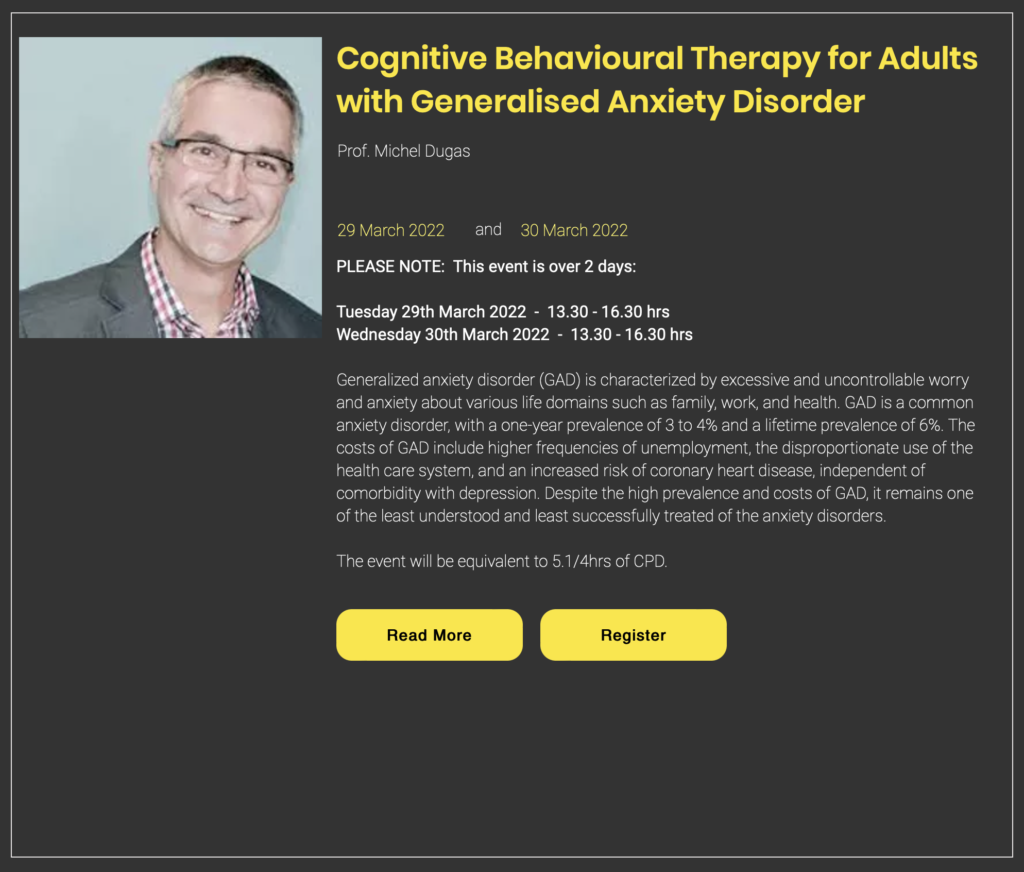
Videoconference (VC) based psychotherapy offers an alternative to face-to-face therapy and increases accessibility. It has particularly become more prevalent throughout the COVID-19 pandemic where much healthcare contact transitioned online (Perrin, Rybarczyk, Pierce, Jones, Shaffer & Islam, 2020).
The working alliance is a key element involved in therapeutic change (Davis, Garske & Martin, 2000) and involves three components: agreement on goals, agreement on therapeutic tasks and establishment of a therapeutic bond. Together, these components contribute to the development of a strong and effective working alliance. The working alliance is considered to have a considerable impact on treatment efficacy, however there are some concerns that VC based psychotherapy may minimise the working alliance, therefore impacting treatment outcomes.
Very little research has taken into consideration key treatment mechanisms, such as intolerance of uncertainty, when investigating the working alliance. Intolerance of uncertainty is considered a key contributing factor to the maintenance of Generalised Anxiety Disorder (GAD) (Hebert & Dugas, 2019). Reduction in intolerance of uncertainty may lead to decreased worry and anxiety and is therefore an important variable to consider when investigating what leads to improved outcomes following CBT treatment.
Utilising an existing data set from a randomised control trial of cognitive behavioural therapy (CBT) delivered by VC for GAD, Marcotte-Beaumier and colleagues examined the relationship between the working alliance components and treatment outcome. First, they examined whether any of the three components of the working alliance, as perceived by the participant, predicted treatment outcome, hypothesising that agreement on the task would predict treatment outcome. Secondly, they explored whether a change in intolerance of uncertainty would mediate the relationship between the components of the working alliance and treatment outcome.

How is the working alliance affected by intolerance of uncertainty in videoconference delivered CBT for anxiety?
Methods
46 adults (40 female, mean age 42.39) with a primary diagnosis of GAD received 15 sessions of VC delivered CBT as part of their involvement in a randomised control trial (see Watts et al., 2020). The original sample consisted of 69 participants, however, participants with missing outcome data were excluded from analysis. Treatment outcome was assessed via change in GAD symptoms from pre-treatment to the 6-month follow up, intolerance of uncertainty was assessed from pre- to- posttreatment, and the working alliance was assessed after the 5th therapy session. Pearson correlation analysis was used to test hypothesis 1 with mediation analysis used to test hypothesis 2.
Results
Pearson correlations revealed that hypothesis 1 was partially supported. Agreement on therapeutic goals (r=0.42; P=.004 and tasks (r=0.37; P=.01) both significantly predicted changes in treatment outcomes. Therapeutic bond (r=−0.23; P=.12) was not a significant predictor of treatment changes.
Further mediation analyses were conducted. The first mediation model using the ‘goal’ subscale did not support hypothesis 2. Change in intolerance of uncertainty did not mediate the relationship between agreement on goals or treatment outcomes (reduction in GAD symptoms), resulting in a non-significant relationship (r=0.04; P=.03).
The second mediation model utilising the WAI task subscale of the working alliance did support hypothesis 2, with scores sufficiently predicting changes in intolerance of uncertainty. Additionally, changes in intolerance of certainty significantly predicted changes in anxiety symptoms and treatment outcomes (pre-treatment to the 6-month follow up). Once this effect was accounted for, the direct effect of the WAI task subscale on change in intolerance of uncertainty were no longer significant. The WAI task subscale had a significant, indirect effect on changes in anxiety symptoms and treatment outcomes and was mediated by the change in intolerance of uncertainty, with a medium effect size (r2=0.12).

Agreement on therapeutic goals and tasks both significantly predicted change in treament outcomes in anxiety.
Conclusions
The authors concluded
Agreement on goals has a direct impact on changes in symptoms, whereas agreement on tasks has an indirect effect via changes in intolerance of uncertainty. This suggests the importance of ensuring that the patient and therapist agree on the goals and tasks to be performed in therapy to ensure optimal treatment success. Our results also highlight the role of the working alliance in understanding the mechanisms of change in GAD. Future studies should examine whether the relationship between working alliance and treatment outcome is, in fact, due to agreement on the goals and tasks to be performed in therapy, rather than on the therapeutic bond.

Agreement on goals has a direct impact on changes in anxiety symptoms, whereas agreement on tasks has an indirect impact via changes in intolerance of uncertainty.
Strengths and limitations
A key strength of this study is that it is the first to examine the mediating role of individual components of the working alliance on treatment outcomes following videoconference CBT. It also paves the way for future research on this area.
As with all research there are several limitations observed by the authors and I. Firstly, I am interested as to why session 5 was chosen as the time point to complete the Working Alliance Inventory (WAI) questionnaire. As far as I am aware, there is no rationale for this reported in the paper (although could be reported in the initial RCT) nor any background literature that may support this decision. The authors themselves also acknowledge this as a limitation, reporting that the content of session 5 could have easily influenced respondents’ responses, introducing an element of bias. Was session 5 chosen based on existing use of the questionnaire? Is it that by session 5, a working alliance is said to be established?
A second limitation, although not addressed by the authors, was on the generalisability of the findings. The sample size was small and mostly females, and although prevalence rates of anxiety disorders are often higher in females than males, the findings of this study cannot be generalised to both men and women. There was also no mention (although, again it could have been reported in the previous RCT) of ethnicity. We know that ethnicity is an important factor to consider in all research due to various reasons, including language, culture, and accessibility. By not reporting ethnicity data, the findings cannot be generalised.

This is the first study to examine the mediating role of individual components of the working alliance on treatment outcomes, however limitations regarding generalisability should be considered.
Implications for practice
Contrary to previous research, this study demonstrates that VC-delivered CBT is not a barrier to the establishment of a strong working alliance and successful treatment outcomes. It paves the way for further research into the area, with a larger more generalisable sample. The findings additionally provide clinical implications for routine CBT practice, such as clinicians being aware of how agreement on tasks can lead to changes in intolerance of uncertainty and a decrease in symptoms. The working alliance is also shown to behave as a facilitative factor in the reduction of GAD (generalised anxiety disorder) symptoms, indicating that, patients who feel they are involved in the decision making of tasks, are more likely to tolerate uncertainty, compared to patients who do not feel this way. This implies the importance of shared decision making in clinical settings (Drake, Cimpean, & Torrey, 2009) being valued as the client and working collaboratively to ensure effective outcomes. This may be particularly relevant during VC-delivered CBT, but future research is required.

This study paves the way for future research and enables clinicians to have a stronger understanding of how the working alliance can be established during videoconferencing.
Statement of interests
There are no conflicts of interest for the authors in writing this article.
Join Prof Michel Dugas on 29-30 March 2022
Bespoke Mental Health are hosting an online webinar on Cognitive Behavioural Therapy for Adults with Generalised Anxiety Disorder (GAD), which will be led by Prof Michel Dugas who was an author of the paper covered in this blog.
This workshop will present cognitive-behavioural treatment options for adults with GAD. Treatment options, which are based on the intolerance of uncertainty model of GAD, include (1) motivational interviewing, (2) behavioural experiments for intolerance of uncertainty, (3) problem-solving training, and (4) imaginal exposure. Each treatment option will be tied to the scientific literature, presented in a step-by-step fashion, and illustrated using clinical material. Data from clinical trials of two different treatment protocols based on the intolerance of uncertainty model will be presented. The workshop will conclude with a discussion of how treatment options can be tailored to the needs of each person suffering from GAD.
Find out more and sign up on the Bespoke Mental Health website.
Links
Primary paper
Marcotte-Beaumier, G., Bouchard, S., Gosselin, P., Langlois, F., Belleville, G., Marchand, A., & Dugas, M. J. (2021). The Role of Intolerance of Uncertainty and Working Alliance in the Outcome of Cognitive Behavioral Therapy for Generalized Anxiety Disorder Delivered by Videoconference: Mediation Analysis. JMIR Mental Health, 8(3), e24541.
Other references
Davis, M. K., Garske, J. P., & Martin, D. J. (2000). Relation of the therapeutic alliance with outcome and the other variables: a meta-analysis review. Journal of Consulting and Clinical Psychology, 68(3), 438-450.
Drake, R. E., Cimpean, D., & Torrey, W. C. (2009). Shared decision making in mental health: prospects for personalized medicine. Dialogues in clinical neuroscience, 11(4), 455–463. https://doi.org/10.31887/DCNS.2009.11.4/redrake
Hebert, E. A., & Dugas, M. J. (2019). Behavioral experiments for intolerance of uncertainty: Challenging the unknown in the treatment of generalized anxiety disorder. Cognitive and Behavioral Practice, 26(2), 421-436.
Perrin, P. B., Rybarczyk, B. D., Pierce, B. S., Jones, H. A., Shaffer, C., & Islam, L. (2020). Rapid telepsychology deployment during the COVID‐19 pandemic: A special issue commentary and lessons from primary care psychology training. Journal of Clinical Psychology, 76(6), 1173-1185.
Rees, C. S., & Maclaine, E. (2015). A systematic review of videoconference‐delivered psychological treatment for anxiety disorders. Australian Psychologist, 50(4), 259-264.
Watts, S., Marchand, A., Bouchard, S., Gosselin, P., Langlois, F., Belleville, G., & Dugas, M. J. (2020). Telepsychotherapy for generalized anxiety disorder: Impact on the working alliance. Journal of Psychotherapy Integration, 30(2), 208.
Photo Credits
- Photo by visuals on Unsplash
- Photo by Dylan Ferreira on Unsplash
- Photo by Markus Winkler on Unsplash
- Photo by Cytonn Photography on Unsplash
- Photo by NordWood Themes on Unsplash
- Photo by Matt Taylor on Unsplash

